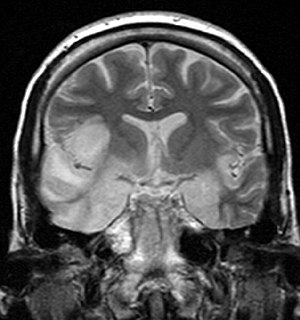Encephalitis
| Encephalitis | |
|---|---|
 |
|
| Coronal T2-weighted MR image shows high signal in the temporal lobes including hippocampal formations and parahippocampal gyrae, insulae, and right inferior frontal gyrus. A brain biopsy was performed and the histology was consistent with encephalitis. PCR was repeated on the biopsy specimen and was positive for HSV | |
| Classification and external resources | |
| Specialty | Neurology, infectious disease |
| ICD-10 | A83-A86, B94.1, G05 |
| ICD-9-CM | 323 |
| DiseasesDB | 22543 |
| MedlinePlus | 001415 |
| eMedicine | emerg/163 |
| MeSH | D004660 |
Encephalitis is a sudden onset inflammation of the brain. Encephalitis with meningitis is known as meningoencephalitis. Symptoms include headache, fever, confusion, drowsiness, and fatigue. Further symptoms include seizures or convulsions, tremors, hallucinations, stroke, and memory problems. In 2013, encephalitis was estimated to have resulted in 77,000 deaths worldwide, down from 92,000 in 1990. The word is from Ancient Greek ἐγκέφαλος, enképhalos "brain", composed of ἐν, en, "in" and κεφαλή, kephalé, "head", and the medical suffix -itis "inflammation".
Adult patients with encephalitis present with acute onset of fever, headache, confusion, and sometimes seizures. Younger children or infants may present irritability, poor appetite and fever. Neurological examinations usually reveal a drowsy or confused patient. Stiff neck, due to the irritation of the meninges covering the brain, indicates that the patient has either meningitis or meningoencephalitis.
Viral encephalitis can occur either as a direct effect of an acute infection, or as one of the sequelae of a latent infection. The most common causes of acute viral encephalitis are rabies virus, HSV infection, poliovirus, and measles virus.
...
Wikipedia
